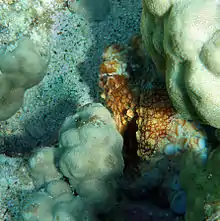Octopus cyanea
Octopus cyanea, also known as the big blue octopus[2] or day octopus,[3] is an octopus in the family Octopodidae. It occurs in both the Pacific and Indian Oceans, from Hawaii to the eastern coast of Africa.[4] O. cyanea grows to 16 cm in mantle length with arms to at least 80 cm.[4] This octopus was described initially by the British zoologist John Edward Gray in 1849; the type specimen was collected off Australia and is at the Natural History Museum in London.[5]
| Big blue octopus | |
|---|---|
 | |
| Scientific classification | |
| Kingdom: | Animalia |
| Phylum: | Mollusca |
| Class: | Cephalopoda |
| Order: | Octopoda |
| Family: | Octopodidae |
| Genus: | Octopus |
| Species: | O. cyanea |
| Binomial name | |
| Octopus cyanea | |
| Synonyms[1] | |
| |
Description
Living as it does on coral reefs, and hunting by day, O. cyanea is adept at camouflage and not only can change colour frequently, but also can change the patterns on and texture of its skin. One researcher observed it change its appearance 1000 times in seven hours.[2][3] As it moves across the seabed it makes changes in its colouring and appearance to match the substrate beneath.[6] The colour changes are instantaneous and made by chromatophores under direct control of the brain.[7] This octopus sometimes produces a "passing clouds" display when stationary near prey such as a crab; this mimics a dark shadow passing across its surface and may encourage the crab to move incautiously.[8]
Distribution
O. cyanea is found on reefs and in shallow waters in the Indo-Pacific. Its range extends from the Red Sea, the East African coast, and Madagascar, to southeastern Asia, Oceania, and as far as Hawaii.[6]
Ecology
While most species of octopus are nocturnal, O. cyanea is diurnal,[3] although mostly crepuscular, being active at dawn and dusk. It maintains a den to which it returns after foraging; a rock crevice, a hidden place under an overhang, a hiding place among coral heads, or a hole excavated in rubble or sand.[9]
It is a predator and searches the reef for fish, crabs, shrimp, and molluscs. Small items may be eaten where they are caught, while larger items are carried back to the den for consumption. Crabs may be killed by a bite and given an injection of toxic saliva, then chewed up in the beak of the octopus, while molluscs may have their shells drilled and the animal inside being predigested to ease extraction. Empty mollusc shells and crab carapaces are discarded outside the den, forming a midden.[3][6]
They sometimes engage in cooperative hunting with the roving coral grouper.[10]
O. cyanea has a lifespan of 12-15 months after settling from the planktonic larval state. During this time, it grows from about 67 to 6,500 g (0.1 to 14.3 lb).[11] Its growth curve is nearly exponential and it converts its prey into new growth with an efficiency greater than 50%, relying on protein for growth, energy production, and energy reserves.[12]
In captivity, it breeds at any time of year, probably depending on when the female reaches maturity. Mating may become cannibalistic.[13] The male may mate with several different females, but after this, the suckers on the edge of his webbing expand in size. During the next two to three months, they continue enlarging while the octopus goes into a decline and dies. Meanwhile, the female remains beside her eggs that are deposited in a den, and dies soon after they hatch.[11]
References
- Bouchet, Philippe (2010). "Octopus cyanea Gray, 1849". WoRMS. World Register of Marine Species. Retrieved 26 April 2017.
- "Octopus cyanea:Big blue octopus". Encyclopedia of Life. Retrieved 1 May 2017.
- "Day octopus". Monterey Bay Aquarium. Retrieved 26 April 2017.
- Norman, M.D. 2000. Cephalopods: A World Guide. ConchBooks.
- Current Classification of Recent Cephalopoda
- "Day Octopuses, Octopus cyanea". MarineBio. Archived from the original on 9 November 2017. Retrieved 1 May 2017.
- Hanlon, Roger T.; Messenger, John B. (1998). Cephalopod Behaviour. Cambridge University Press. p. 38. ISBN 978-0-521-64583-6.
- Mather, Jennifer A.; Mather, D. Lynn (2004). "Apparent movement in a visual display: the 'passing cloud' of Octopus cyanea (Mollusca: Cephalopoda)". Journal of Zoology. 263 (1): 89–94. doi:10.1017/S0952836904004911.
- "Octopus cyanea: Big blue octopus". SeaLifeBase. Retrieved 26 April 2017.
- Vail A.L., Manica A., Bshary R., Referential gestures in fish collaborative hunting, in Nature Communications, vol. 4, 2013.
- van Heukelem, William F. (1973). "Growth and life-span of Octopus cyanea (Mollusca: Cephalopoda)". Journal of Zoology. 169 (3): 299–315. doi:10.1111/j.1469-7998.1973.tb04559.x.
- New Scientist. Reed Business Information. 3 November 1983. pp. 333–334. ISSN 0262-4079.
- Hanlon, Roger T.; Forsythe, John W. (March 2008). "Sexual cannibalism by Octopus cyanea on a Pacific coral reef". Marine and Freshwater Behaviour and Physiology. 41 (1): 19–28. doi:10.1080/10236240701661123.
External links
- "CephBase: Octopus cyanea". Archived from the original on 2005.
- Photos of Octopus cyanea on Sealife Collection

